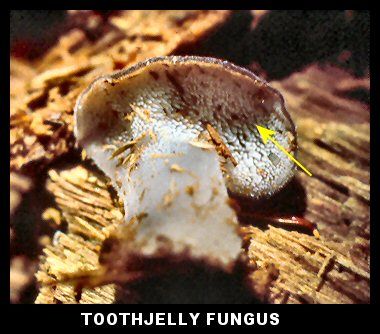
The Toothjelly Fungus (Pseudohydnum gelatinosum) is found mostly on conifer logs; its clusters may be seen from the end of fall to mid-winter. This species is unique in that its flesh is rubbery-gelatinous. Also, the Toothjelly Fungus has minute conic spines on which the spores are produced — in contrast to the true tooth fungi, which have fleshy to fibrous/leathery tissues and are not gelatinous. The translucent, gelatinous make-up of the toothed jelly species adds it to the list of unusual fungal species which are easy to identify.
As a novice mushroom observer, I am often surprised when examining a seemingly unusual fungal specimen to discover that it is actually easy to identify. Recognizing typical mushrooms with radial, blade-like gills and others with toothed, spike-like gills is commonplace; sponge-like gills have always been obvious as prominent features for boletes and related mushroom species.
This Toothjelly Fungus example was photographed as a solitary specimen in a damp, woodland setting, back in late September 1977. Here, growing on rotting wood, was a gelatinous, translucent fungus that resembled other mushroom types. When I took a close look at the grayish blob and turned it over, its identifying features became evident and the Toothjelly Fungus was added to my mental collection of marvelous natural discoveries.
Copyright © 2005–2006 William T. Hathaway.